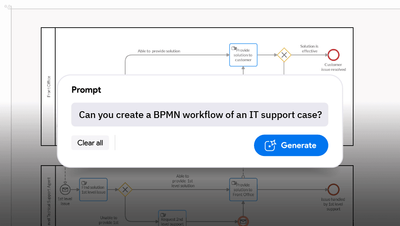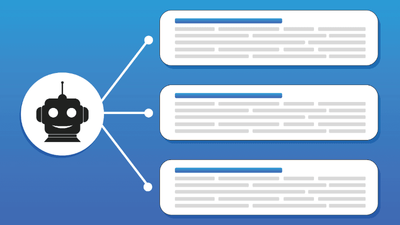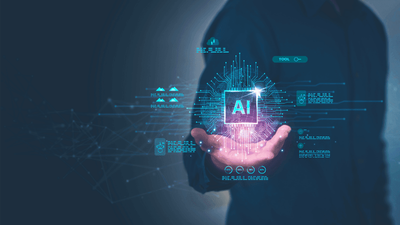AI in BPM: how industries and business analysts can harness the power of AI BPMN generators
Written by Andrea
21 October 2025 · 5 min read

Artificial Intelligence (AI) is rapidly transforming how organizations design and manage their business processes. While discussions about AI in Business Process Management (BPM) often revolve around automation, the true transformation begins earlier, in how processes are understood, modeled, and continuously improved.
What is an AI BPMN generator?
An AI BPMN generator is an artificial intelligence–powered tool that helps create Business Process Model and Notation (BPMN) diagrams automatically from text prompts, data, or existing workflows.
Instead of manually drawing each task and connector, users describe a process in plain language, and the AI instantly produces a structured BPMN diagram.
In essence, it transforms process ideas into formal models, combining AI efficiency with business analysis expertise.
What are the benefits of using AI in BPMN modeling?
Integrating AI into BPM helps teams model and optimize workflows faster, smarter, and more accurately. Here are the key advantages:
- Faster process modeling: AI BPMN generators can turn business requirements into draft process diagrams within seconds, saving hours of manual modeling.
- Improved accuracy: AI identifies inconsistencies, missing gateways, or loops in BPMN models, reducing human error and improving model quality.
- Smarter collaboration: AI tools make it easier for teams to collaborate in real time, refining suggestions and validating logic directly within the modeling tool.
- Continuous optimization: By analyzing historical data, AI can suggest process improvements or alternative paths based on performance patterns.
- Accessibility for non-experts: Even those without deep BPMN expertise can describe their workflows and let AI produce a compliant, well-structured model.

How is AI transforming BPM across industries?
AI is reshaping Business Process Management (BPM) across multiple sectors, enabling organizations to connect data, people, and decisions more effectively.
AI in BPM use case: Automating loan approvals, fraud detection, and compliance workflows
Resulting benefit: Faster, safer, more compliant processes
AI in BPM use case: Modeling patient journeys, scheduling, and diagnostics
Resulting benefit: Better patient flow and resource management
AI in BPM use case: Predictive maintenance and supply chain optimization
Resulting benefit: Reduced downtime and cost savings
AI in BPM use case: Customer journey mapping and inventory process modeling
Resulting benefit: Improved customer experience and stock alignment
AI in BPM use case: Automating permit and citizen service processes
Resulting benefit: Faster service delivery and higher transparency
In each of these industries, an AI BPMN generator helps model and refine workflows faster, bridging the gap between operational complexity and strategic goals.

How do business analysts enable AI in BPM (BA4AI)?
During the BA & Beyond conference we had the opportunity to attend a few months back, we heard different business analysts’ views on AI. At the same time, we understand how business consultant Fabricio Laguna emphasizes in his article on the International Institute of Business Analysis (IIBA) website, that the rise of AI doesn’t eliminate the need for business analysis, it redefines it.
As Fabricio says, there’s already ‘a series of AI4BA (artificial intelligence for business analysis) publications and training programs showing how we can use this new technology to increase productivity and quality’. Fabrico continues: ‘The motto is: AI may not replace you, but if you don’t use it, you’ll be replaced by someone who does’. Hence why we need to shift this. BA4AI means shifting from “what AI can do for business analysts” to “what business analysts must do for AI.”
Business analysts prepare the structure, clarity, and intent that make AI effective. Here’s how:
- Define clear business outcomes: Analysts guide AI toward measurable goals like efficiency, compliance, or customer satisfaction — for example, reducing loan approval times in banking or ensuring audit readiness in healthcare.
- Provide quality input: AI BPMN generators learn from well-defined business rules, accurate data, and consistent terminology — much like how retail companies train AI systems using standardized product and inventory data.
- Validate and govern: Analysts ensure every AI-generated process remains transparent, ethical, and aligned with company standards, as seen in financial institutions implementing governance frameworks for automated decision-making.
- Bridge human and machine logic: Analysts interpret AI output, confirm context, and preserve the intent behind each workflow — for instance, refining AI-suggested customer support flows to reflect actual service policies.
- Focus on human skills: Communication, reasoning, and empathy remain vital. These are what give meaning to AI-driven processes — from redesigning employee onboarding in HR to improving patient care coordination in hospitals.
In short, AI needs human logic to make sense, and business analysts provide that logic.
How can organizations navigate the transition to intelligent BPM?
Adopting AI in BPM isn’t only a technical shift, it’s a cultural one.
As AI BPMN generators become standard tools, teams need to adjust how they collaborate, validate results, and trust automation.
- Business analysts must lead this transition, ensuring AI suggestions align with real-world business needs.
- Data quality and transparency must become shared responsibilities, not IT-only concerns.
- Governance frameworks should define how AI-generated models are reviewed and approved.
The key challenge (and opportunity) lies in balance: using AI for speed and insight while preserving human judgment and accountability.
What’s next: the future of AI in Cardanit
At Cardanit, we’ve always believed that the future of process modeling lies in the collaboration between people and technology.
Since 1999, ESTECO, the company behind Cardanit, has been pioneering applications of machine learning and AI in complex engineering and business environments.
Building on that legacy, we’re now bringing AI directly into BPMN modeling. Our team is developing an AI BPMN generator designed to help analysts turn process ideas into visual models faster and more intuitively.
This innovation enhances, rather than replaces, the role of business analysts, combining AI-assisted suggestions with human insight to make modeling more accurate and collaborative.
We’re preparing to launch a beta version of our AI BPMN generator soon, and we can’t wait to share it with our community.
Stay tuned for updates on Cardanit’s AI BPMN generator beta release, and be among the first to experience intelligent modeling in action.
Conclusion
AI is transforming how organizations design, analyze, and optimize business processes.
With tools like the AI BPMN generator, teams can model faster, experiment more freely, and make process management truly intelligent.
Yet technology alone isn’t enough. The future of BPM lies in the partnership between human expertise and AI, a collaboration that Cardanit is proud to be leading.
Further reading
Business analysts' conference focused on AI
The growing complexities and innovations in Business Process Mining
Andrea is the collective pseudonym for the group of people working behind Cardanit, the Business Process Management Software as a Service of ESTECO. The group has different backgrounds and several decades of experience in fields varying from BPM, BPMN, DMN, Process Mining, Simulation, Optimization, Numerical Methods, Research and Development, and Marketing.
Andrea is the collective pseudonym for the group of people working behind Cardanit, the Business Process Management Software as a Service of ESTECO. The group has different backgrounds and several decades of experience in fields varying from BPM, BPMN, DMN, Process Mining, Simulation, Optimization, Numerical Methods, Research and Development, and Marketing.
People also ask
A BPMN editor allows you to manually draw workflows. An AI BPMN generator uses natural language or data inputs to generate those workflows automatically.
No. AI assists in speed and structure, but human judgment ensures accuracy, compliance, and business alignment.
A beta version will be released soon. Users will be invited to test and help shape its development.
All data is managed under strict privacy and compliance standards. AI suggestions remain within a controlled environment.
A business is only as efficient as its processes. What are you waiting to improve yours?
